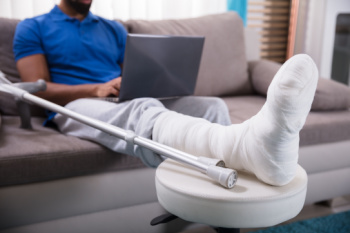Connect With Us
Blog

A broken foot can happen from a fall, a heavy object landing on the foot, or even repeated stress from activities that place too much pressure on the bones. Many people notice sudden pain, swelling, bruising, or difficulty putting weight on the foot right after the injury. In some cases, the discomfort may seem mild at first, but quickly worsens with walking. The area might feel tender to touch, and shoes may become uncomfortable due to swelling. Even small fractures can interfere with balance and everyday movement if they are not recognized early. Rest, elevation, and avoiding weight on the foot are usually important first steps until proper care is given. If you suspect a foot fracture because of persistent pain, swelling, or trouble walking, it is suggested that you schedule an appointment with a podiatrist for an accurate diagnosis and appropriate treatment plan.
A broken foot requires immediate medical attention and treatment. If you need your feet checked, contact one of our podiatrists from DM Foot & Ankle Associates . Our doctors can provide the care you need to keep you pain-free and on your feet.
Broken Foot Causes, Symptoms, and Treatment
A broken foot is caused by one of the bones in the foot typically breaking when bended, crushed, or stretched beyond its natural capabilities. Usually the location of the fracture indicates how the break occurred, whether it was through an object, fall, or any other type of injury.
Common Symptoms of Broken Feet:
- Bruising
- Pain
- Redness
- Swelling
- Blue in color
- Numbness
- Cold
- Misshapen
- Cuts
- Deformities
Those that suspect they have a broken foot shoot seek urgent medical attention where a medical professional could diagnose the severity.
Treatment for broken bones varies depending on the cause, severity and location. Some will require the use of splints, casts or crutches while others could even involve surgery to repair the broken bones. Personal care includes the use of ice and keeping the foot stabilized and elevated.
If you have any questions, please feel free to contact our office located in Lemont, IL . We offer the newest diagnostic and treatment technologies for all your foot care needs.

Many people reach for running shoes when they head out for a walk, and in many cases this choice works well. Running shoes are designed to absorb impact, support forward motion, and cushion the feet during repetitive steps. These features can make walking more comfortable, especially on hard surfaces. However, not every running shoe suits every walker. Some styles are built for speed and may feel too firm or too curved for a steady walking pace. Others have extra cushioning that can change how the foot contacts the ground. Paying attention to how your feet feel during and after a walk is the best guide. If discomfort, pressure points, or unusual fatigue develop, it is suggested that you schedule an appointment with a podiatrist for personalized footwear advice.
If you are a runner, wearing the right running shoe is essential. For more information, contact one of our podiatrists from DM Foot & Ankle Associates . Our doctors can provide the care you need to keep you pain-free and on your feet.
Choosing the Right Running Shoe for Your Foot Type
To increase performance and avoid the risk of injury, it is important to choose the right running shoe based on your foot type. The general design of running shoes revolves around pronation, which is how the ankle rolls from outside to inside when the foot strikes the ground.
- Neutral runners are able to choose from a wide variety of shoes, including minimalist shoes or even going barefoot.
- Runners who overpronate, or experience an over-abundance of ankle rolling, should choose shoes that provide extra motion control and stability.
- Runners who underpronate, or supinate, have feet that have high arches and lack flexibility, preventing shock absorption. They require shoes with more flexibility and cushion.
If you have any questions, please feel free to contact our office located in Lemont, IL . We offer the newest diagnostic and treatment technologies for all your foot care needs.

Sesamoiditis is a painful inflammation of the tiny sesamoid bones located beneath the big toe joint. These small bones act like pulleys, helping the tendons move smoothly and absorb pressure with every step. When they become irritated from overuse, repetitive impact, or increased activity on hard surfaces, pain develops directly under the big toe. Many people describe a deep ache or sharp discomfort that worsens when pushing off the toe while walking. Swelling, tenderness, and difficulty bending the big toe are common signs. Dancers, runners, people with high arches, and anyone who spends long hours on their feet are more prone to this condition. Without proper care, symptoms can progress and interfere with daily movement. Rest, wearing supportive footwear, and targeted treatments can provide relief. If you notice persistent pain beneath your big toe or difficulty bearing weight, it is suggested that you see a podiatrist for an evaluation and personalized treatment.
Sesamoiditis is an unpleasant foot condition characterized by pain in the balls of the feet. If you think you’re struggling with sesamoiditis, contact one of our podiatrists of DM Foot & Ankle Associates . Our doctors will treat your condition thoroughly and effectively.
Sesamoiditis
Sesamoiditis is a condition of the foot that affects the ball of the foot. It is more common in younger people than it is in older people. It can also occur with people who have begun a new exercise program, since their bodies are adjusting to the new physical regimen. Pain may also be caused by the inflammation of tendons surrounding the bones. It is important to seek treatment in its early stages because if you ignore the pain, this condition can lead to more serious problems such as severe irritation and bone fractures.
Causes of Sesamoiditis
- Sudden increase in activity
- Increase in physically strenuous movement without a proper warm up or build up
- Foot structure: those who have smaller, bonier feet or those with a high arch may be more susceptible
Treatment for sesamoiditis is non-invasive and simple. Doctors may recommend a strict rest period where the patient forgoes most physical activity. This will help give the patient time to heal their feet through limited activity. For serious cases, it is best to speak with your doctor to determine a treatment option that will help your specific needs.
If you have any questions, please feel free to contact our office located in Lemont, IL . We offer the newest diagnostic and treatment technologies for all your foot care needs.
